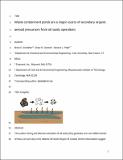Notice
This is not the latest version of this item. The latest version can be found at:https://dspace.mit.edu/handle/1721.1/138418.2
Waste Containment Ponds Are a Major Source of Secondary Organic Aerosol Precursors from Oil Sands Operations
| dc.contributor.author | Drollette, Brian D | |
| dc.contributor.author | Gentner, Drew R | |
| dc.contributor.author | Plata, Desiree L | |
| dc.date.accessioned | 2021-12-10T15:00:10Z | |
| dc.date.available | 2021-12-10T15:00:10Z | |
| dc.date.issued | 2020 | |
| dc.identifier.uri | https://hdl.handle.net/1721.1/138418 | |
| dc.description.abstract | Copyright © 2020 American Chemical Society. The surface mining and bitumen extraction of oil sands (OS) generates over one million barrels of heavy oil each day in the Alberta Oil Sands Region of Canada. Recent observations suggest that emissions from OS development contribute to secondary organic aerosol (SOA) formation, but the chemical composition, mass fluxes, and sources of those emissions are poorly delineated. Here, we simulated OS extraction and used comprehensive two-dimensional gas chromatography to quantify and characterize direct air emissions, bitumen froth, residual wastewater, and tailings components, ultimately enabling fate modeling of over 1500 chromatographic features simultaneously. During the non-ice cover season, tailings ponds emissions contributed 15000-72000 metric tonnes of hydrocarbon SOA precursors, translating to 3000-13000 tonnes of SOA, whereas direct emissions during the extraction process itself were notably smaller (960 ± 500 tonnes SOA yr-1). These results suggest that tailings pond waste management practices should be targeted to reduce environmental emissions. | en_US |
| dc.language.iso | en | |
| dc.publisher | American Chemical Society (ACS) | en_US |
| dc.relation.isversionof | 10.1021/ACS.EST.0C01735 | en_US |
| dc.rights | Creative Commons Attribution-Noncommercial-Share Alike | en_US |
| dc.rights.uri | http://creativecommons.org/licenses/by-nc-sa/4.0/ | en_US |
| dc.source | Prof. Plata | en_US |
| dc.title | Waste Containment Ponds Are a Major Source of Secondary Organic Aerosol Precursors from Oil Sands Operations | en_US |
| dc.type | Article | en_US |
| dc.identifier.citation | Drollette, Brian D, Gentner, Drew R and Plata, Desiree L. 2020. "Waste Containment Ponds Are a Major Source of Secondary Organic Aerosol Precursors from Oil Sands Operations." Environmental Science and Technology, 54 (16). | |
| dc.relation.journal | Environmental Science and Technology | en_US |
| dc.eprint.version | Author's final manuscript | en_US |
| dc.type.uri | http://purl.org/eprint/type/JournalArticle | en_US |
| eprint.status | http://purl.org/eprint/status/PeerReviewed | en_US |
| dc.date.updated | 2021-12-10T14:48:49Z | |
| dspace.orderedauthors | Drollette, BD; Gentner, DR; Plata, DL | en_US |
| dspace.date.submission | 2021-12-10T14:48:51Z | |
| mit.journal.volume | 54 | en_US |
| mit.journal.issue | 16 | en_US |
| mit.license | OPEN_ACCESS_POLICY | |
| mit.metadata.status | Authority Work and Publication Information Needed | en_US |
